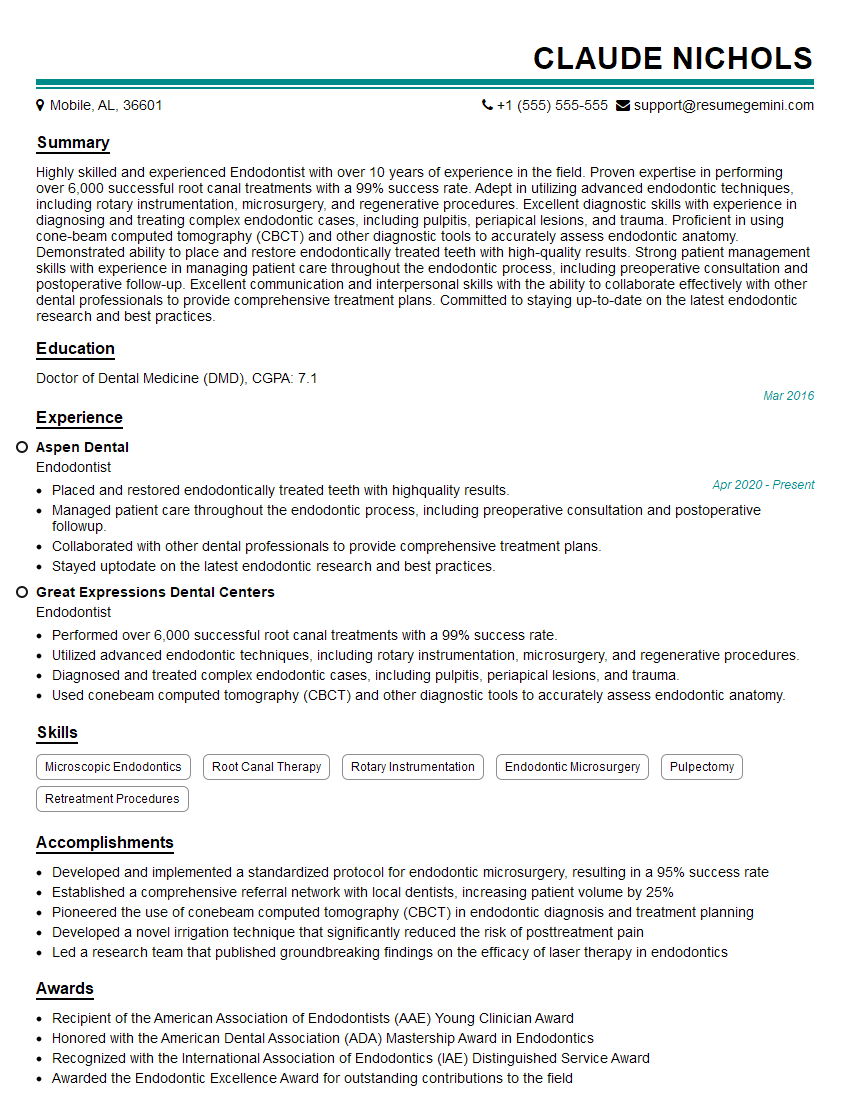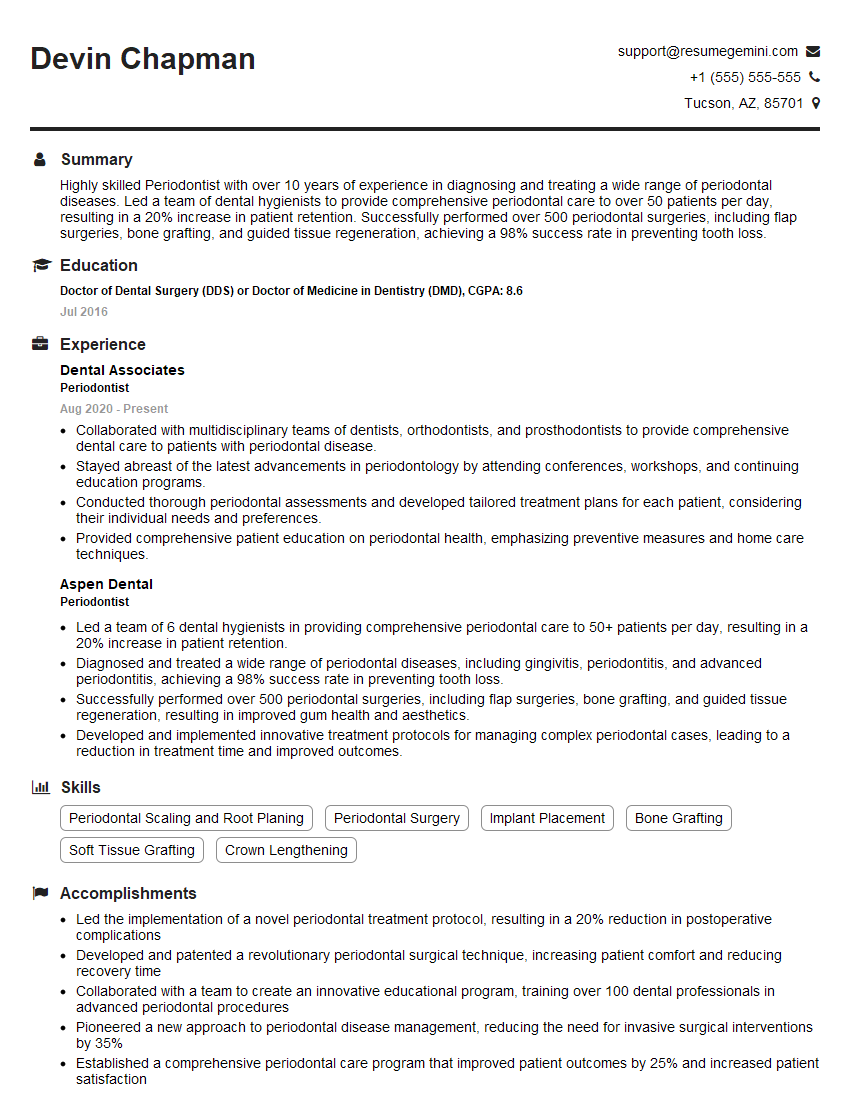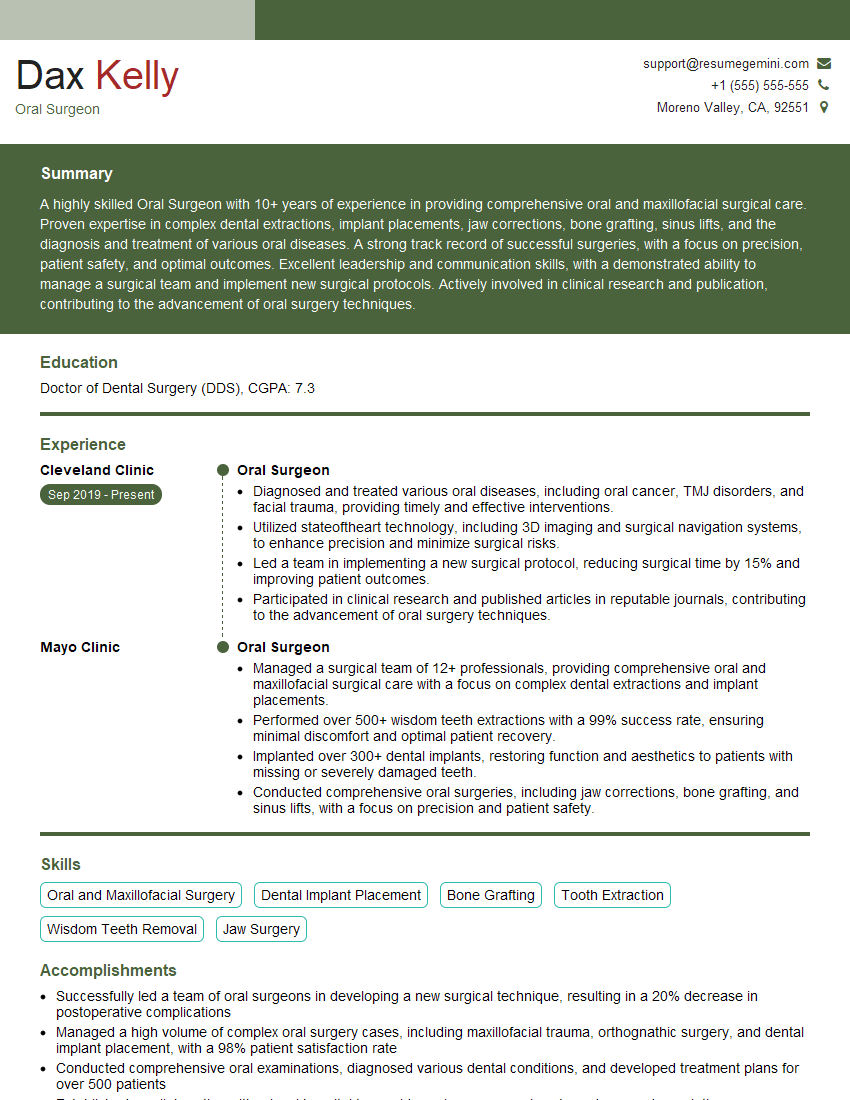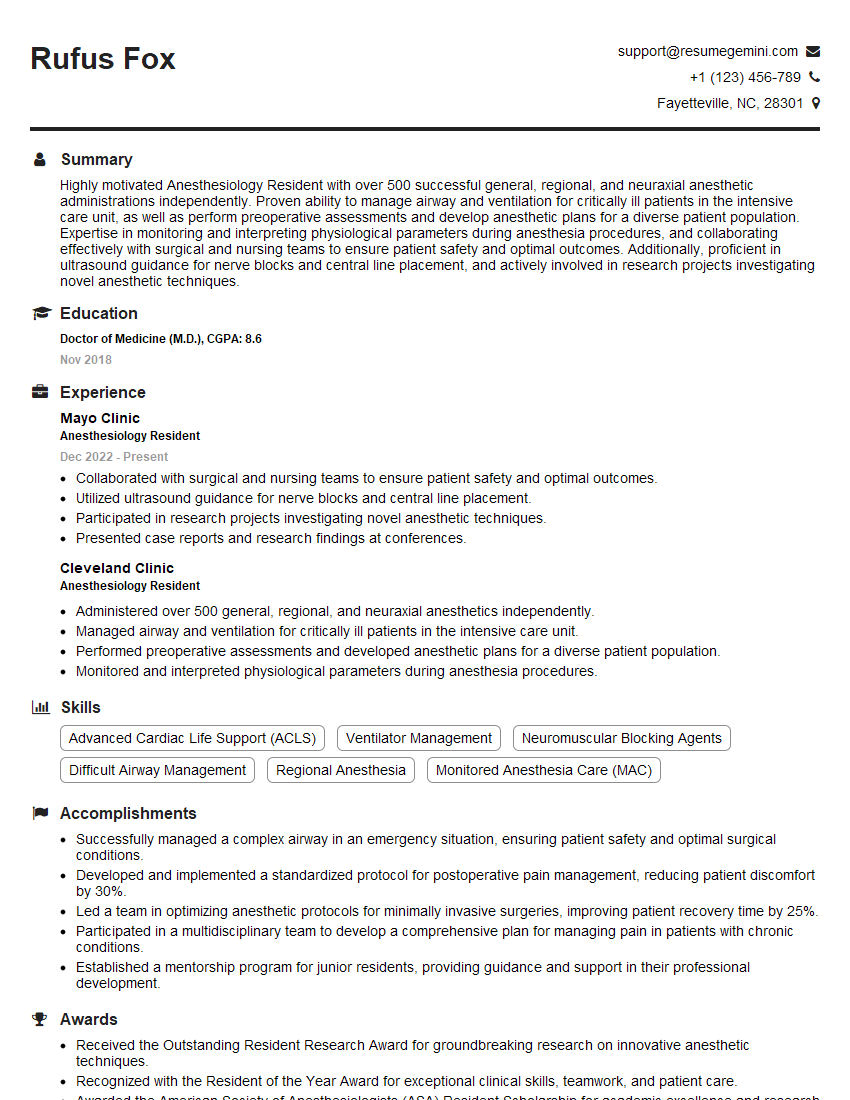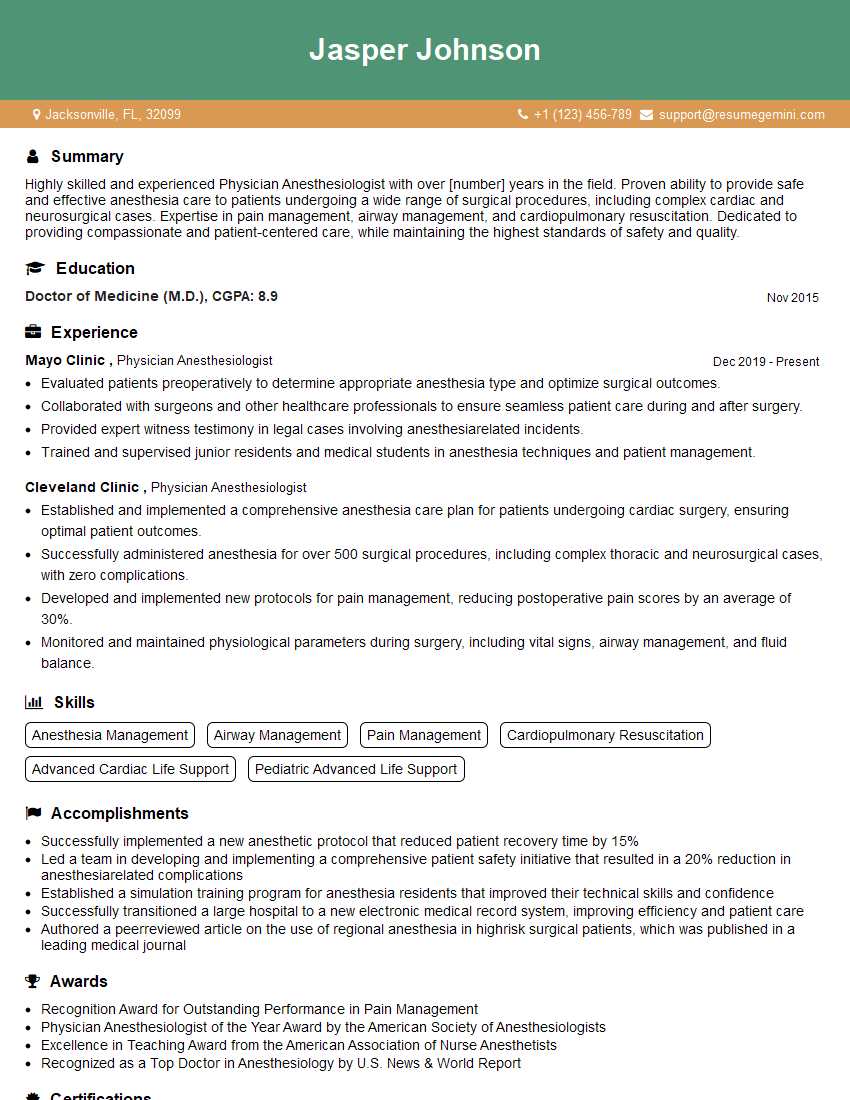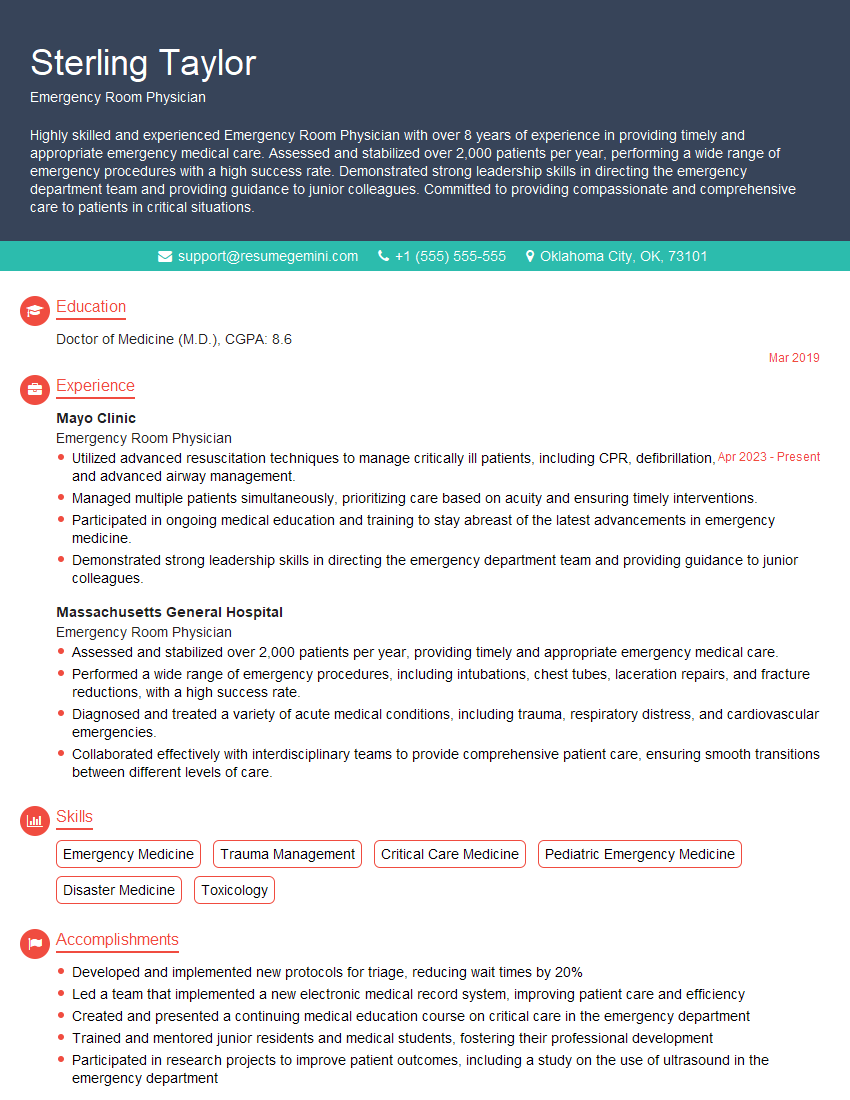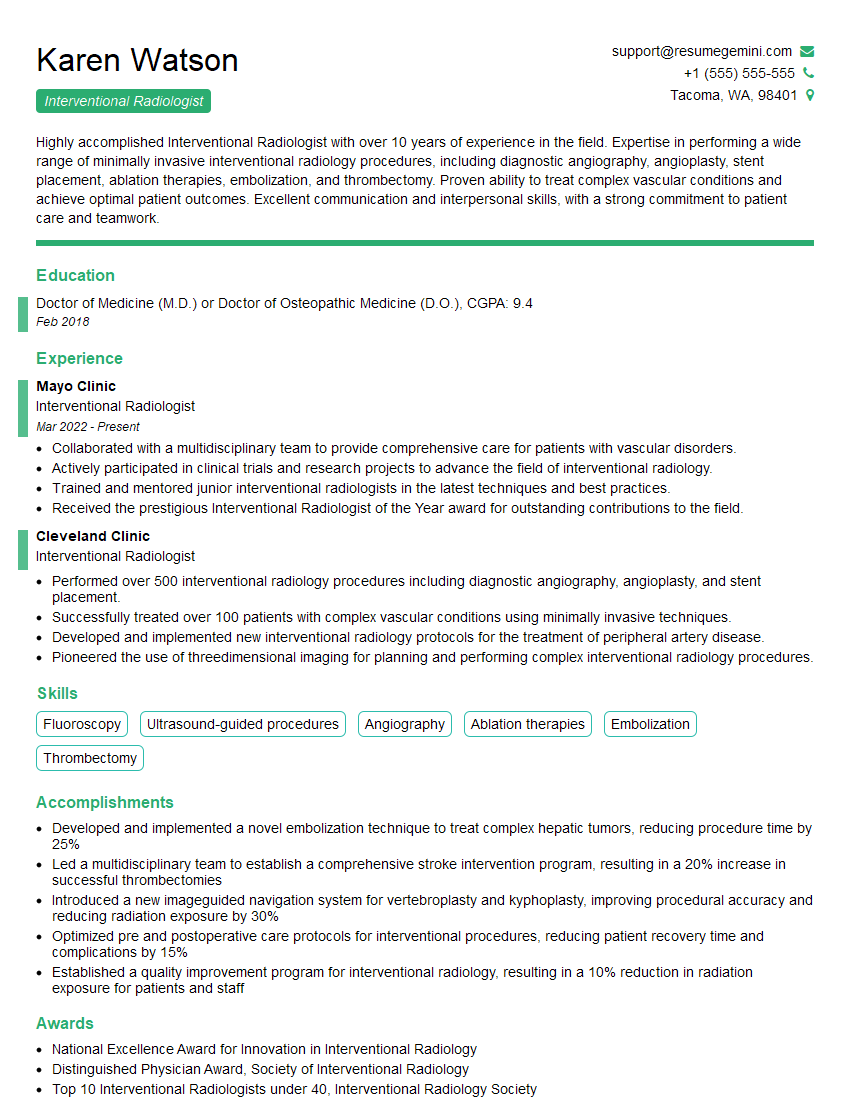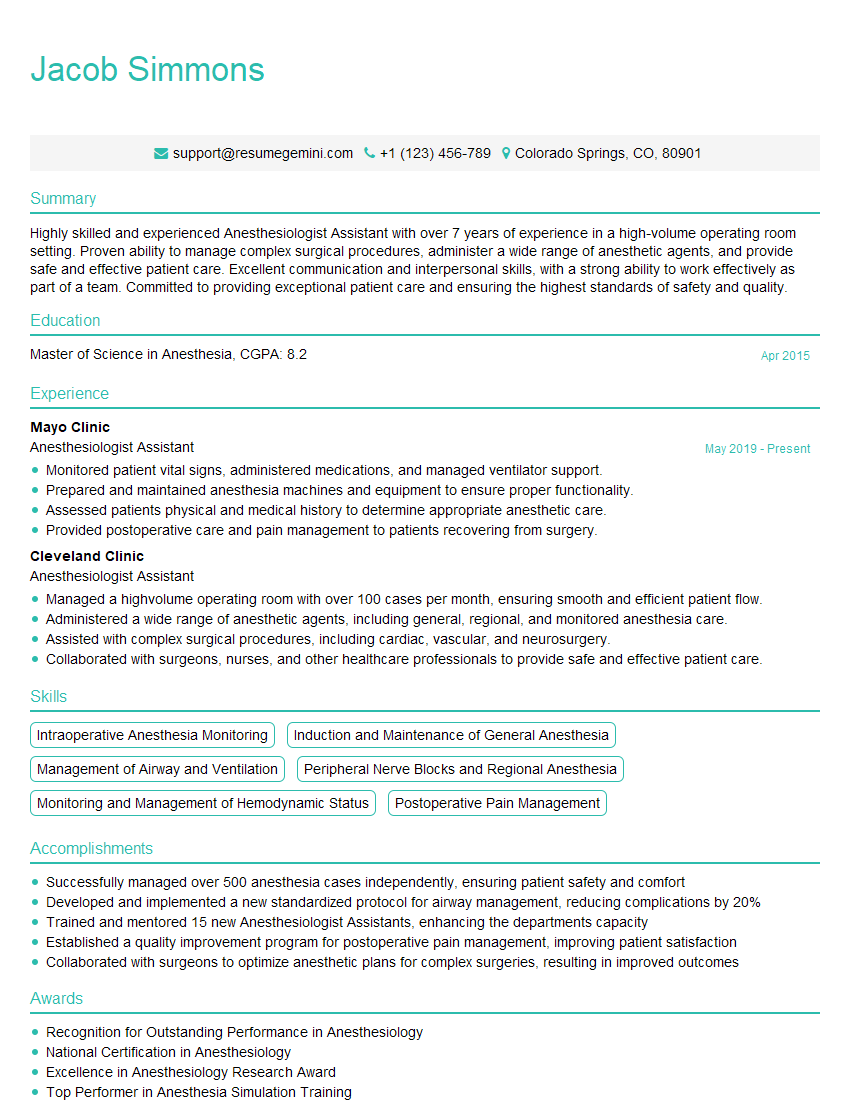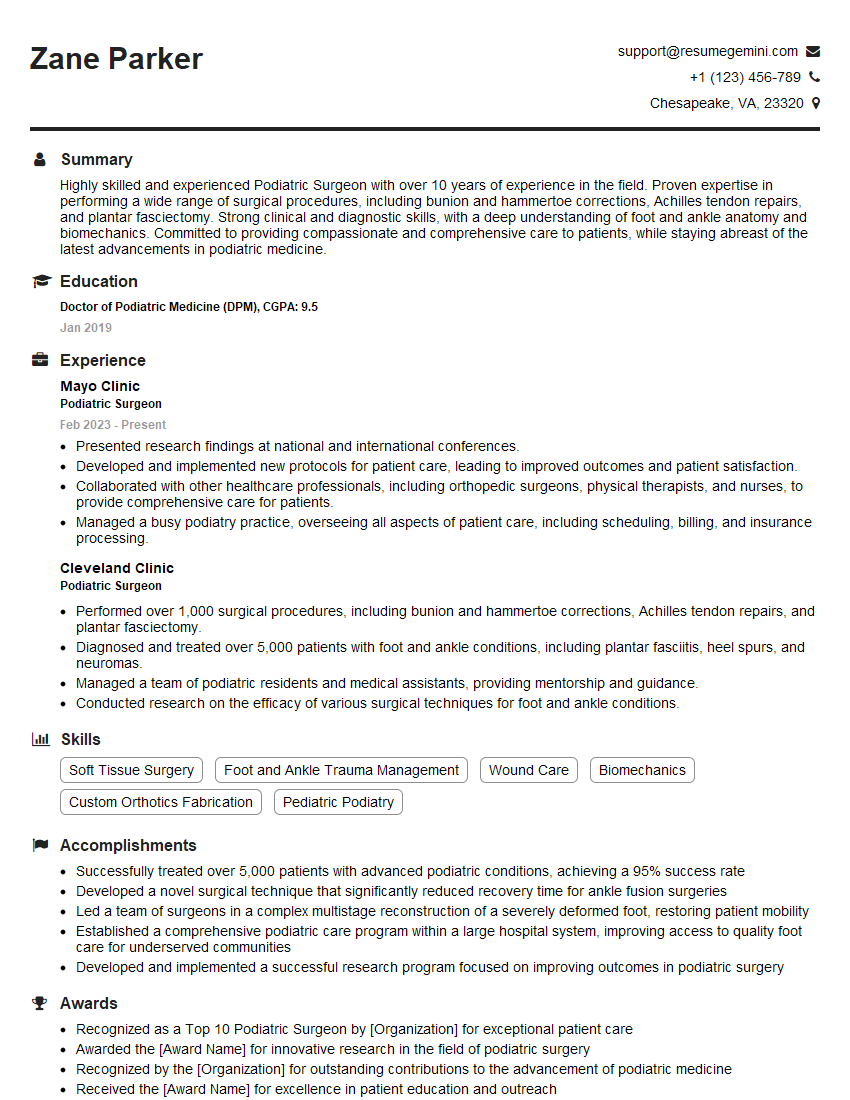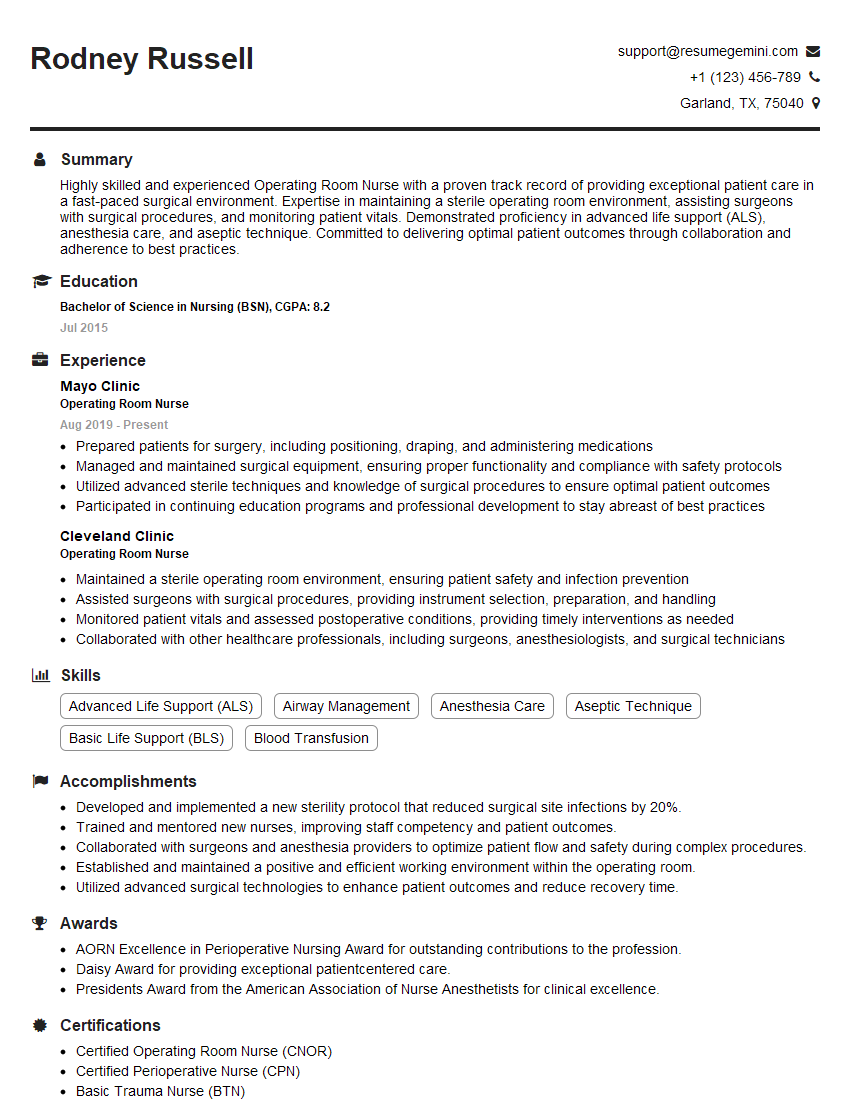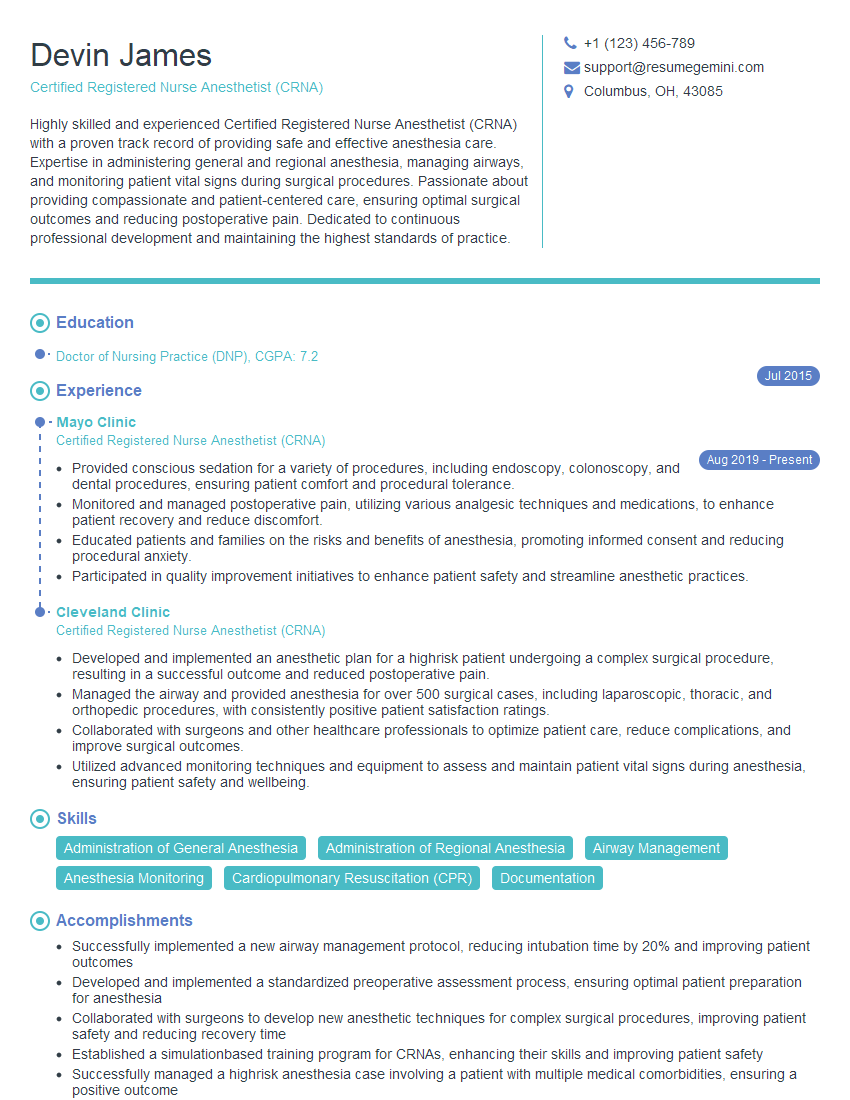Interviews are opportunities to demonstrate your expertise, and this guide is here to help you shine. Explore the essential Local Anesthesia Administration interview questions that employers frequently ask, paired with strategies for crafting responses that set you apart from the competition.
Questions Asked in Local Anesthesia Administration Interview
Q 1. Describe the difference between local, regional, and general anesthesia.
The key difference between local, regional, and general anesthesia lies in the extent of the area affected by the anesthetic agent. Think of it like this: local anesthesia is a small, targeted area; regional anesthesia numbs a larger region, and general anesthesia affects the entire body.
- Local Anesthesia: This involves numbing a small, specific area. For example, a dentist using lidocaine to numb a single tooth before a filling is using local anesthesia. The patient remains awake and conscious.
- Regional Anesthesia: This targets a larger area, often a limb or a specific nerve group. Examples include spinal anesthesia (epidural) used for childbirth or lower extremity surgery, or a brachial plexus block for arm surgery. The patient is awake but the targeted area is completely numb.
- General Anesthesia: This induces a state of unconsciousness. The patient loses all sensation and awareness, used for major surgical procedures.
Q 2. What are the common contraindications for local anesthesia administration?
Contraindications for local anesthesia administration are situations where using it would be dangerous or ineffective. These can be broadly categorized as patient-related or medication-related:
- Patient-related: Severe allergies to local anesthetics (especially amide-type), known heart conditions (especially severe bradycardia), severe hypertension, and pregnancy (depending on the type and stage). Patient’s psychological state should also be considered, for example a very anxious patient might not be a good candidate for certain regional techniques.
- Medication-related: Interactions with other medications the patient is taking (such as certain antibiotics) can be relevant. The specific agent chosen and the patient’s medical history (liver or kidney impairment) should always be considered.
A thorough medical history and physical exam are crucial before administering any local anesthetic to identify these contraindications.
Q 3. Explain the mechanism of action of amide and ester local anesthetics.
Both amide and ester local anesthetics work by blocking nerve conduction, preventing pain signals from reaching the brain. However, they differ in their chemical structure and metabolism:
- Amide Local Anesthetics (e.g., lidocaine, bupivacaine, ropivacaine): These are metabolized primarily in the liver. They are generally considered less likely to cause allergic reactions compared to esters.
- Ester Local Anesthetics (e.g., procaine, cocaine, tetracaine): These are metabolized primarily by plasma pseudocholinesterases. They are more likely to cause allergic reactions because of faster hydrolysis and potential for degradation by-products.
In both cases, the mechanism involves binding to voltage-gated sodium channels in the nerve cell membrane, inhibiting the influx of sodium ions and thus preventing the propagation of action potentials – the electrical signals that transmit pain sensations.
Q 4. What are the signs and symptoms of local anesthetic toxicity?
Local anesthetic toxicity, usually from unintentional intravascular injection or overdose, can manifest in a range of symptoms, progressing in severity:
- Early Signs (CNS): Lightheadedness, dizziness, tinnitus (ringing in the ears), blurred vision, circumoral numbness (numbness around the mouth), metallic taste.
- Intermediate Signs (CNS): Drowsiness, disorientation, slurred speech, tremors, muscle twitching, seizures.
- Severe Signs (CNS): Grand mal seizures, coma, respiratory depression, cardiovascular collapse.
- Cardiovascular Effects: Bradycardia (slow heart rate), hypotension (low blood pressure), arrhythmias (irregular heartbeats). These can appear independently or in combination with CNS symptoms.
The progression is usually rapid and requires immediate intervention.
Q 5. How do you manage a patient experiencing a toxic reaction to a local anesthetic?
Managing a toxic reaction requires immediate action and depends on the severity of symptoms:
- Early Signs: Monitor vital signs, consider stopping the procedure. Simple supportive measures may suffice.
- Intermediate/Severe Signs: Immediate emergency intervention is required. This involves securing the airway, supporting ventilation with oxygen (possibly assisted ventilation), administering anticonvulsants to control seizures (e.g., diazepam or propofol), and managing cardiovascular effects with appropriate medications (e.g., epinephrine, atropine, fluids). Cardiac monitoring is essential.
- Intravenous Lipid Emulsion (ILE): In severe cases, intravenous lipid emulsion therapy can be life-saving. ILE acts by extracting local anesthetics from the lipid bilayer, aiding their metabolism. Administration is done through intravenous injection.
Immediate transfer to a critical care unit is frequently necessary.
Q 6. Describe the proper technique for performing an infraorbital nerve block.
The infraorbital nerve block anesthetizes the skin and mucous membranes of the lower eyelid, cheek, upper lip, and nasal vestibule. The technique involves:
- Patient Positioning and Preparation: The patient should be comfortably positioned, and the area should be cleaned with antiseptic.
- Landmark Identification: Palpate the infraorbital foramen, located approximately 0.5 cm below the infraorbital margin of the orbit. You can use the patient’s pupil as a landmark.
- Needle Insertion: Insert a 25-27 gauge needle at a 45-degree angle to the skin, directed towards the infraorbital foramen. Aspirate before injection to rule out intravascular injection.
- Anesthetic Injection: Slowly inject 1-2 mL of local anesthetic solution. Observe for patient response.
- Confirmation of Block: Assess the area for sensory changes to confirm the anesthetic block.
It is crucial to avoid injecting into blood vessels to prevent systemic toxicity. Aspirating prior to injection is mandatory.
Q 7. What are the different types of local anesthetic delivery techniques?
Various methods deliver local anesthetics, each with its advantages and disadvantages:
- Topical Application: This is the simplest method, applying the anesthetic cream or gel directly to the skin. Useful for minor procedures and has slow onset.
- Infiltration Anesthesia: This involves injecting the anesthetic directly into the tissues surrounding the surgical site. Widely used for many surgical procedures.
- Nerve Block: Anesthetic is injected near specific nerves, providing anesthesia to a larger area than infiltration. Examples include infraorbital, brachial plexus and dental blocks.
- Regional Anesthesia (Epidural, Spinal, Caudal): Anesthetic is injected into the epidural space, subarachnoid space, or caudal canal for widespread anesthesia of the body’s region. Often used in obstetrics and major surgeries.
- Intravenous Regional Anesthesia (Bier Block): A tourniquet is applied to a limb, followed by injection of the local anesthetic into the venous system of the limb. Used for short procedures.
The choice of technique depends on the extent and location of the needed anesthesia, the type of procedure, and patient factors.
Q 8. How do you calculate the maximum safe dose of a local anesthetic?
Calculating the maximum safe dose of a local anesthetic is crucial to patient safety. It’s not a simple single number, but rather a calculation based on the patient’s weight and the specific local anesthetic being used. We use the patient’s weight in kilograms (kg) and multiply it by the maximum dose in milligrams (mg) per kilogram recommended by the manufacturer for that specific drug. For example, if the maximum dose of lidocaine without epinephrine is 4.5 mg/kg and the patient weighs 70 kg, the maximum dose would be 70 kg * 4.5 mg/kg = 315 mg. This is just a starting point though. The calculation needs to be adjusted based on several factors, including the patient’s age, overall health, presence of liver or kidney disease, and whether the local anesthetic is being used with a vasoconstrictor like epinephrine, which can prolong its effect and allow for a slightly higher dose to be used safely. Always consult the package insert for precise dosage recommendations and adjust your calculation accordingly. It’s always better to err on the side of caution and use a lower dose than risk exceeding the maximum safe dose.
Q 9. Explain the importance of aspiration before injecting local anesthetic.
Aspiration before injecting local anesthetic is a critical step in preventing intravascular injection, a serious complication that can lead to systemic toxicity, including cardiac arrest. Imagine injecting directly into a blood vessel – the drug would quickly enter the bloodstream, bypassing the localized effect and leading to dangerously high blood levels. By aspirating (drawing back on the plunger of the syringe before injection), we check for the presence of blood in the syringe. If blood is present, it indicates that the needle tip is within a blood vessel, and the injection should be stopped immediately. The needle should be repositioned, and the aspiration procedure repeated before injecting again. This simple but crucial step significantly reduces the risk of systemic toxicity and ensures patient safety. It’s a critical part of best practice in local anesthetic administration and a non-negotiable aspect of patient care. Failing to aspirate can have potentially catastrophic consequences.
Q 10. What are the potential complications associated with local anesthesia administration?
Potential complications associated with local anesthesia administration can range from minor to severe. Minor complications might include pain at the injection site, hematoma (bruising), swelling, or transient paresthesia (numbness or tingling). More serious complications are fortunately less common but can include intravascular injection (as mentioned earlier) leading to systemic toxicity, local anesthetic systemic toxicity (LAST), which can manifest as symptoms such as dizziness, lightheadedness, seizures, and cardiovascular collapse. Allergic reactions, although rare, are also possible. Nerve damage is another rare but potentially serious complication, usually resulting from direct needle trauma to a nerve. Infection at the injection site is also a possibility if sterile technique isn’t strictly followed. Early recognition of complications and immediate appropriate management are crucial to minimize adverse effects.
Q 11. How do you assess a patient’s suitability for local anesthesia?
Assessing a patient’s suitability for local anesthesia involves a thorough medical history and physical examination. We need to identify any contraindications or risk factors that might make local anesthesia unsafe or less effective. This includes assessing allergies (especially to local anesthetics or preservatives), current medications (certain drugs can interact with local anesthetics), presence of systemic diseases (such as heart disease, liver or kidney disease, or bleeding disorders), and the patient’s overall health status. A patient’s anxiety level and understanding of the procedure should also be considered; adequate patient education and reassurance are essential. Pregnancy and breastfeeding also require careful consideration and may necessitate adjusting the type and dosage of local anesthetic used. A detailed medical history is the cornerstone of a safe local anesthetic administration. Knowing the patient’s risks allows us to make informed decisions about the most appropriate anesthetic choice, dosage and technique.
Q 12. Describe the different types of needles used for local anesthesia administration.
Several types of needles are used for local anesthesia administration, primarily differentiated by their length, gauge (diameter), and bevel. Shorter needles (e.g., 25-gauge, 1-inch needles) are often used for superficial injections, while longer needles (e.g., 27-gauge, 1.5-inch needles) might be necessary for deeper infiltrations. The gauge refers to the needle diameter, with smaller gauge numbers indicating larger diameter needles. A 25-gauge needle is smaller and thinner than a 27-gauge. The bevel, the slanted tip of the needle, can influence the ease of injection. Different types of needles are best suited for different anatomical locations and procedures. The selection of the appropriate needle is part of what makes for safe and efficient local anesthetic administration. Using the wrong needle type can cause discomfort and potentially lead to complications.
Q 13. How do you manage bleeding during a local anesthesia injection?
Managing bleeding during a local anesthesia injection involves several steps. Firstly, applying firm, direct pressure to the injection site after the injection helps to control minor bleeding. If the bleeding is more significant, sterile gauze pads should be used to exert pressure until the bleeding stops. In some cases, a cold compress might be helpful to constrict blood vessels. In most instances, minor bleeding stops within a short time with this direct pressure. However, if bleeding persists despite direct pressure, or if a significant hematoma forms, it may require further intervention, potentially including suturing if necessary. Proper aseptic technique should always be employed to minimize the risk of infection during and after the procedure. It’s important to carefully monitor the site to ensure that no excessive bleeding or hematoma develops. This prevents complications and maintains patient comfort.
Q 14. What are the different types of local anesthetic cartridges available?
Local anesthetic cartridges come in a variety of formulations. They primarily differ in the type and concentration of the local anesthetic agent, as well as the presence or absence of a vasoconstrictor, typically epinephrine. Common local anesthetics include lidocaine, bupivacaine, and prilocaine. Epinephrine is often added to prolong the duration of action of the anesthetic and reduce bleeding at the injection site by causing vasoconstriction, which reduces blood flow to the area. The concentration of the local anesthetic is another important variable, with higher concentrations providing greater and longer-lasting anesthesia but also carrying a higher risk of toxicity. Cartridges also contain sodium chloride and other additives to maintain the solution’s stability and compatibility. The selection of the appropriate cartridge is always dependent upon the specific procedure and patient characteristics. For example, a long-acting anesthetic like bupivacaine might be preferred for longer procedures while a rapidly acting one like lidocaine might be preferred for short ones. Reading package inserts thoroughly before usage is paramount for selecting the best local anesthetic cartridge for each case.
Q 15. How do you select the appropriate concentration and volume of local anesthetic?
Selecting the appropriate concentration and volume of local anesthetic is crucial for effective pain management and patient safety. It depends on several factors including the type of procedure, the area being anesthetized, the patient’s age and overall health, and the specific local anesthetic agent chosen.
Concentration: Higher concentrations generally provide faster onset and deeper anesthesia, but also increase the risk of toxicity. For example, a 2% lidocaine solution is more potent than a 1% solution. The choice depends on the procedure’s needs. A simple dental procedure might use a lower concentration than a major surgical intervention.
Volume: The required volume depends on the size of the area to be anesthetized and the tissue’s vascularity. A highly vascular area will require a larger volume to achieve adequate anesthesia because the anesthetic is quickly absorbed into the bloodstream. We calculate the maximum allowable dose based on the patient’s weight and the local anesthetic’s toxicity profile to avoid systemic toxicity. For instance, a larger patient might tolerate a higher volume than a smaller patient.
Careful consideration of both concentration and volume is essential to ensure effective anesthesia while minimizing adverse effects. This involves understanding the pharmacokinetic and pharmacodynamic properties of the specific anesthetic agent used.
Career Expert Tips:
- Ace those interviews! Prepare effectively by reviewing the Top 50 Most Common Interview Questions on ResumeGemini.
- Navigate your job search with confidence! Explore a wide range of Career Tips on ResumeGemini. Learn about common challenges and recommendations to overcome them.
- Craft the perfect resume! Master the Art of Resume Writing with ResumeGemini’s guide. Showcase your unique qualifications and achievements effectively.
- Don’t miss out on holiday savings! Build your dream resume with ResumeGemini’s ATS optimized templates.
Q 16. What is the role of vasoconstrictors in local anesthesia?
Vasoconstrictors, most commonly epinephrine, play a vital role in local anesthesia by prolonging the duration of anesthesia and reducing bleeding at the surgical site. They achieve this by constricting blood vessels, thereby decreasing the rate of local anesthetic absorption into the systemic circulation. This slower absorption means the anesthetic stays localized at the target area for a longer period, allowing the procedure to be completed without the need for repeated injections.
Imagine a sponge soaked in water. If the sponge is tightly squeezed (vasoconstriction), the water (anesthetic) remains within the sponge (target tissue) for a longer time. Without vasoconstriction, the water would quickly leach out.
Q 17. What are the advantages and disadvantages of using vasoconstrictors?
Advantages of using vasoconstrictors:
- Prolonged anesthesia: Allows for longer procedures without requiring additional injections.
- Reduced bleeding: Improves surgical visibility and reduces the risk of hematoma formation.
- Decreased systemic toxicity: By slowing the absorption of the local anesthetic, the risk of systemic toxicity is lowered.
Disadvantages of using vasoconstrictors:
- Potential for cardiovascular complications: Epinephrine, particularly in high doses or in patients with cardiovascular disease, can increase heart rate and blood pressure. This necessitates careful patient selection and monitoring.
- Tissue necrosis: In areas with limited blood supply, vasoconstriction can potentially lead to tissue necrosis. This is why vasoconstrictors are generally avoided in areas like fingers and toes.
- Increased pain on injection: Some patients report increased pain at the injection site with the addition of a vasoconstrictor.
The decision to use a vasoconstrictor should be made on a case-by-case basis, weighing the benefits against potential risks and carefully considering the patient’s individual circumstances.
Q 18. Describe the process of preparing a patient for local anesthesia.
Preparing a patient for local anesthesia involves several key steps to ensure patient comfort and safety. This starts with a thorough medical history review, identifying any potential contraindications, such as allergies to local anesthetics or vasoconstrictors, and pre-existing cardiovascular conditions. We also assess the patient’s understanding of the procedure, including potential risks and benefits, and address any anxieties they may have.
Next, we explain the procedure and how the anesthesia will feel, focusing on communicating clearly and honestly. Patient positioning is important for optimal access to the injection site and comfort. Finally, we ensure the skin is cleansed with an antiseptic solution to minimize the risk of infection at the injection site. We use appropriate sterile techniques throughout the process. We may use topical anesthetic cream before the injection to reduce initial discomfort.
Q 19. How do you document the administration of local anesthesia?
Documentation of local anesthesia administration is crucial for legal and medical reasons. It must include the type and amount of local anesthetic used, the presence or absence of vasoconstrictors, the injection sites, the patient’s response to the anesthesia, and any adverse effects noted. I always record the time of injection, the patient’s vital signs before and after the procedure, and the overall effectiveness of the anesthesia. Any complications or unexpected events are meticulously documented. I also note the patient’s post-injection assessment including pain level. Accurate and complete documentation is essential for continuity of care and protecting both the patient and the practitioner.
Q 20. What are the post-operative instructions for patients who received local anesthesia?
Post-operative instructions for patients who received local anesthesia are essential for ensuring proper healing and preventing complications. Instructions typically include:
- Monitoring for adverse effects: Patients should be advised to watch for signs of allergic reactions (rash, itching, swelling) or signs of systemic toxicity (dizziness, lightheadedness).
- Pain management: Instructions on using prescribed pain relievers, as needed.
- Wound care: Specific instructions for wound care, if applicable, are given, including keeping the area clean and dry.
- Activity restrictions: Depending on the procedure, certain activity restrictions may be necessary.
- Follow-up appointments: Scheduling any necessary follow-up appointments.
Clear and concise instructions, tailored to the patient’s individual needs and the nature of the procedure, are critical for successful post-operative recovery.
Q 21. How do you handle a failed local anesthesia attempt?
A failed local anesthesia attempt is a challenging situation requiring careful assessment and management. The first step is to reassess the technique, considering factors such as the injection site, needle placement, and the amount of local anesthetic injected. It’s crucial to rule out any anatomical variations or unexpected tissue resistance that might have hindered the spread of the anesthetic. We may use ultrasound guidance for better needle placement precision in challenging areas.
If the initial attempt fails, we might consider using a different type or concentration of local anesthetic. An alternative approach may involve a nerve block technique if appropriate for the area. In situations where local anesthesia is insufficient, we would discuss alternative options with the patient, such as regional anesthesia or general anesthesia, depending on the clinical situation. It’s crucial to always prioritize patient comfort and safety. Thorough documentation of the failed attempt and the subsequent actions taken is essential.
Q 22. What are the signs and symptoms of infection at the injection site?
Infection at a local anesthesia injection site is a serious complication that requires prompt attention. Early signs can be subtle, but a vigilant clinician will identify them. Classic signs include redness, swelling, warmth, and tenderness to the touch at the injection site. Pus formation (abscess) is a clear indication of infection. You might also see localized pain that increases progressively, rather than subsiding as expected after the procedure. Systemic signs, such as fever, chills, or malaise (a general feeling of discomfort), indicate a more widespread infection and require immediate medical intervention. For example, I once had a patient develop a small abscess after a dental block; prompt drainage and antibiotic therapy resolved the issue quickly. However, delayed treatment can lead to serious complications like cellulitis or even sepsis.
Q 23. How do you manage pain at the injection site after local anesthesia administration?
Managing post-injection pain is crucial for patient comfort and satisfaction. The initial pain at the injection site is often transient and can be addressed with simple analgesics like acetaminophen or ibuprofen. For more significant pain, a short course of stronger analgesics such as opioids might be considered, but always mindful of potential side effects and the need for careful monitoring. Applying ice packs to the injection site can help reduce swelling and pain. In some cases, a local anesthetic with a longer duration of action can help minimize post-procedure discomfort. For example, I routinely use a combination of lidocaine and bupivacaine for longer-lasting pain relief in certain procedures. Patient education about the expected course of pain and methods of self-management are also essential components of good pain management. Clear instructions on appropriate analgesic use and when to seek further medical attention are critical.
Q 24. What is your experience with different types of nerve blocks?
My experience encompasses a broad range of nerve blocks, from simple peripheral nerve blocks (e.g., digital blocks, intercostal blocks) to more complex regional techniques (e.g., brachial plexus blocks, femoral nerve blocks, lumbar plexus blocks). I am proficient in various approaches, including the superficial, perivascular, and paravertebral routes. For instance, I routinely perform supraclavicular brachial plexus blocks for shoulder surgery. The choice of technique depends on the specific anatomical location, target nerves, and the planned procedure. A thorough understanding of the anatomy and potential complications associated with each type of nerve block is essential for successful and safe administration. I’m also experienced in using image guidance, which substantially improves the precision and safety of nerve blocks, minimizing the risk of inadvertent injection into non-target structures like blood vessels or nerves.
Q 25. Describe your experience managing adverse reactions to local anesthesia.
Managing adverse reactions to local anesthetics is a critical part of my practice. These reactions can range from mild (e.g., localized swelling, bruising) to severe (e.g., systemic toxicity, anaphylaxis). Mild reactions typically require only observation and reassurance. More serious reactions necessitate immediate intervention. For instance, I’ve treated several patients who experienced cardiovascular toxicity – characterized by hypotension, bradycardia, or cardiac arrhythmias. Prompt management with supportive measures, such as intravenous fluids and vasopressors, is crucial. In cases of allergic reactions, immediate administration of epinephrine is essential, followed by supportive care, including oxygen therapy and antihistamines. A well-equipped emergency cart and the availability of emergency personnel are vital in managing such scenarios. A thorough patient history – including allergies and previous anesthetic experiences – is crucial in minimizing the risks of adverse reactions.
Q 26. Discuss the use of ultrasound-guided regional anesthesia.
Ultrasound-guided regional anesthesia has revolutionized the field. It significantly improves the accuracy and safety of nerve blocks by providing real-time visualization of the target nerve and surrounding structures. This reduces the risk of inadvertent injection into blood vessels or non-target nerves. I use ultrasound guidance routinely for many nerve blocks, including those in the brachial plexus, femoral nerve, and lumbar plexus. The improved visualization enables precise needle placement and confirmation of successful injection. For example, ultrasound guidance has been instrumental in reducing the incidence of failed blocks or complications such as hematomas or nerve injury. Furthermore, it allows for smaller volumes of local anesthetic to be used, reducing systemic toxicity risk. This technology enhances patient safety and leads to better outcomes.
Q 27. Explain your understanding of different local anesthetic formulations.
Local anesthetic formulations vary widely, and selecting the appropriate formulation is essential for successful pain management. They differ in their chemical structure (e.g., amide vs. ester), onset of action, duration of action, and the addition of vasoconstrictors like epinephrine. Amide-type anesthetics, such as lidocaine, bupivacaine, and ropivacaine, are more commonly used due to a lower incidence of allergic reactions. Epinephrine is often added to prolong the duration of action and reduce bleeding at the injection site. Choosing the right formulation depends on factors such as the type of procedure, the required duration of anesthesia, and the patient’s medical history. For example, short-acting anesthetics like lidocaine are ideal for brief procedures, whereas long-acting agents like bupivacaine are used for longer procedures or post-operative analgesia. Understanding the pharmacokinetics and pharmacodynamics of different formulations is crucial for safe and effective administration.
Q 28. How do you maintain sterility during local anesthesia procedures?
Maintaining sterility during local anesthesia procedures is paramount to preventing infection. This involves strict adherence to aseptic techniques throughout the procedure. This includes hand hygiene using an alcohol-based hand rub, wearing sterile gloves and a mask, and using sterile equipment, drapes, and needles. The injection site should be cleaned with an appropriate antiseptic solution, such as chlorhexidine or povidone-iodine, to minimize the bacterial load. All equipment should be inspected for any signs of damage or contamination before use. The preparation of the anesthetic solution should also be done aseptically. Any deviation from these strict protocols significantly increases the risk of infection. I always double-check all my equipment and procedures for sterility to ensure patient safety. It’s a non-negotiable part of the procedure.
Key Topics to Learn for Local Anesthesia Administration Interview
- Pharmacology of Local Anesthetics: Understanding different types of local anesthetics (e.g., amides, esters), their mechanisms of action, onset and duration of action, and potential adverse effects.
- Injection Techniques: Mastering various injection techniques (e.g., infiltration, nerve block, field block) and their appropriate applications based on the surgical procedure and anatomical location. Consider the practical implications of different needle sizes and approaches.
- Patient Assessment and Selection: Developing a comprehensive approach to evaluating patient suitability for local anesthesia, including medical history review, allergy assessment, and understanding contraindications.
- Anesthesia Complications and Management: Identifying and effectively managing potential complications such as toxicity, hematoma formation, infection, and nerve damage. Be prepared to discuss your problem-solving approach in such situations.
- Infection Control and Sterile Technique: Demonstrating a thorough understanding of proper infection control protocols and maintaining a sterile field during local anesthesia administration.
- Pain Management Strategies: Beyond the administration itself, explore techniques for optimizing patient comfort and minimizing pain perception before, during, and after the procedure.
- Legal and Ethical Considerations: Understanding relevant legal and ethical standards, including informed consent and documentation practices.
- Advanced Techniques (if applicable): Depending on the specific role, you may need to familiarize yourself with more advanced techniques such as ultrasound-guided regional anesthesia or other specialized approaches.
Next Steps
Mastering Local Anesthesia Administration is crucial for advancing your career and showcasing your expertise in a highly sought-after skillset. A strong understanding of these principles will significantly enhance your job prospects and allow you to contribute effectively to a healthcare team. To increase your chances of securing your dream role, it’s essential to present yourself with a compelling resume that highlights your skills and experience. Creating an ATS-friendly resume is key to ensuring your application is seen by recruiters. We highly recommend using ResumeGemini to build a professional, impactful resume tailored to your specific needs. ResumeGemini provides examples of resumes specifically designed for professionals in Local Anesthesia Administration, helping you present your qualifications effectively and land that interview.
Explore more articles
Users Rating of Our Blogs
Share Your Experience
We value your feedback! Please rate our content and share your thoughts (optional).
What Readers Say About Our Blog
This was kind of a unique content I found around the specialized skills. Very helpful questions and good detailed answers.
Very Helpful blog, thank you Interviewgemini team.
